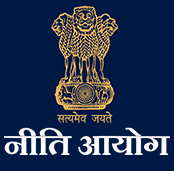Vision for New India@75
When India turns 75 on August 15, 2022, it will mark a moment that comes, but rarely in history, when we step out from the old to the new. It will be the era of a New India; an era where India begins its journey to become a global leader in thought and action. The preparation towards this began in 2017 when Prime Minister Shri Narendra Modi gave his clarion call for establishing aNew India by 2022. In line with this call, the NITI Aayog created the 'Strategy for New India @ 75'released in 2018. This strategy is all the more essential to transform the nation in the post-pandemic world.
The 'Strategy for New India @ 75' had three key messages from the Prime Minister for New India. First, development must become a mass movement, in which every Indian recognizes his/her role and also experiences the tangible benefits accruing to him/her in the form of better ease of living. Second, development strategy should help achieve broad-based economic growth to ensure balanced development across all regions and States and across sectors. Third, the strategy when implemented will bridge the gap between public and private sector performance. The strategy is an attempt to bring innovation, technology, enterprise and efficient management together, at the core of policy formulation and implementation. The term 'policy' is frequently used in government parlance, but what is a 'policy'? In its simplest form, a policy is a framework or plan within which all actions for the accomplishment of an objective are envisioned, implemented, and evaluated. Public policy, by extension, applies to the objectives that pertain to the welfare of the public. The science of policymaking is vast and varied, but like any science, it values analytical thinking, systematic action, and objective evaluation. The life cycle of a policy can be seen in five distinct stages— Problem Identification, Policy Formulation, Policy Adoption, Policy Implementation, and Monitoring and Evaluation.
Given the brisk pace of development in the world today, the development in New India is expected to be achieved sooner than envisioned. Therefore, the policy ecosystem of New India must not fall behind. This cannot be achieved solely by conventional methods. It requires a paradigm shift in the thought process, methods, and tools of the policymakers. For example, the conventional approach to policy is to encourage innovation and regulate technology as the goal of public welfare. While this is still required, it is imperative that policymakers change their perspective from considering innovation and technology an outcome to considering it a tool to achieve their objectives. Similarly, the identified focus areas such as agriculture, industry, information and communication, infrastructure, logistics and transport, education and employment, health and wellness, local governance, etc. require either a sharper focus on implementing the flagship schemes already in place or a new design and initiative to achieve India’s true potential. The following sections draw on the strategy and go a step further to describe how Innovation and Technology can play a role in those areas.
In agriculture, emphasis must shift to converting farmers to 'agripreneurs'. The e-National Agriculture Markets (e-NAMs) should be further expanded. A unified national market, coupled with opening up the export regime, can boost this sector. Automation through the use of IoT (Internet of Things) technology and geospatial data in agriculture should be encouraged. This should start with mobile-based irrigation platforms and extend to precision agriculture that leverages sensor data from the plant, soil, water and air, as well as geospatial data for crop and climate monitoring. Proactive dissemination of techniques on Zero Budget Natural Farming (ZBNF) should be undertaken in low-income rural regions, so as to increase farmers' income and improve land quality.
In industry, the focus must be on encouraging the adoption of Industry 4.0 in MSMEs. Small business research programmes for encouraging R&D in MSMEs need to be established. The support to micro innovations will create a culture of innovation across the workforce.
At the national scale, programmes on Smart and Advanced Manufacturing to address the shortage of high-tech human resources are needed. This also would start with simple automation and leadup to rapid production through 3D printing.
In information and communication infrastructure, the BharatNet project is already underway with the goal of eliminating the digital divide. The challenges in the implementation of its Phase 2 and phase 3, which will complete the last-mile connectivity to every part of the nation, can be met by encouraging the use of advanced communication technologies like mmWave communication and FreeSpace Optics. India's active participation in formulating international standards must increase and expand. As a result of its recent efforts, the 5Gi standard has been approved, which is designed specifically to serve rural and remote regions in developed countries.
In the broad sense of logistics and transport, the Bharatmala project must be expedited and more Dedicated Freight Corridors be established. These projects should be implemented with new materials/techniques developed for construction. The FASTag project is already being implemented, although some streamlining remains. Here, this learning should be expanded to create an IT-enabled traffic management system in urban regions and to geospatial tracking and management for long-haul vehicles. Coastal shipping and inland waterways infrastructure must also develop an IT-enabled platform. This is important for integrating different modes of transport and promoting multi-modal and digitised mobility.
In education and employment, the implementation of the National Education Policy 2020 is underway. At the school education level, flexibility in educational streams and vocational education, clubbed with a new innovation ecosystem at the ground level by expanding the Atal Tinkering Labs program is needed. For higher education, there is a need to increase laboratory facilities and encourage non-linear studies. Such open access to education, clubbed with accelerated lab-to-market processes through Virtual Incubators, must be established. Similarly, re-skilling and up-skilling training through firms or through unemployment assistance programs must be offered. This will rapidly transform the workforce and also offer social security.
In health and wellness, affordable housing in urban areas has been given a huge push to improve workers' living conditions and ensure equity. Looking forward, this can be clubbed with innovative construction technologies and integrated with a circular economy to provide a strong impetus to economic growth. The establishment of a network of Health and Wellness Centres (HWCs) should be complemented with public health programmes through soft touch governance, using targeted messaging and mobilizing the youth. Universal access to basic healthcare can be achieved rapidly through e-Health projects and telemedicine. The popularity of personal health and wellness technologies can be leveraged by supporting innovation in manufacturing of low-cost solutions.
In local governance, the emphasis must be placed to using and enabling technology. Spatial planning using GIS tools and land use monitoring using geospatial data increase the efficiency and productivity of the region. Ward committees and areas should be activated with a technology-enabled 'Open Cities Framework' and the use of digital tools for feedback and reporting. In addition, the Digital Village programme must be scaled up rapidly to encourage the usage of information technology at the village level. This would include provision of citizen-centric services and increasing digital literacy through training. These changes can help achieve an engaged and active relationship between the government and the people.
In State and Central governance, the emphasis must be placed on implementing 'Minimum Government, Maximum Governance'. A major overhaul of the numerous civil services is needed and must be based on a citizen-centric framework implemented through advanced ICT systems. Administrative reforms need to be designed in the changing context of emerging technologies and the growing complexity of the economy. In addition, the scope of Swachh Bharat Mission may be expanded to cover initiatives for landfills, plastic waste and municipal waste and generating wealth from waste. This will create accessible and transparent governance.
Society today places a high value on innovative thinking primarily because it has been able to provide solutions to problems that conventional methods did not. The key insight here is that it is the utility of innovation, not the novelty that makes it so desirable. The most important challenge for New India will be to establish Sustainable Development for a Sustainable Future.
In response to the clarion call by the Honourable Prime Minister of India, it is our Sankalp that innovation and technology be leveraged consciously, to deliver a solution to this challenge for new India. This is the way. The way toward siddhi and beyond for New India@75.
The authors are Neeraj Sinha, Senior Adviser, Naman Agrawal, Senior Associate and Siddhey G Shinde, Young Professional at NITI Aayog.
Views expressed are personal.
 National Portal Of India
National Portal Of India 







